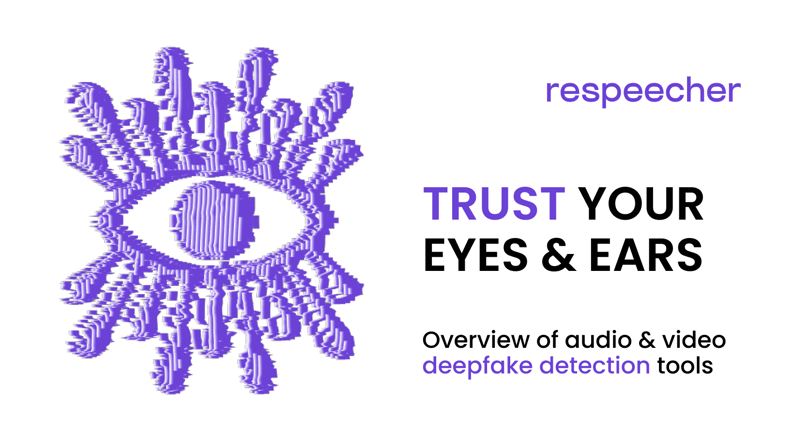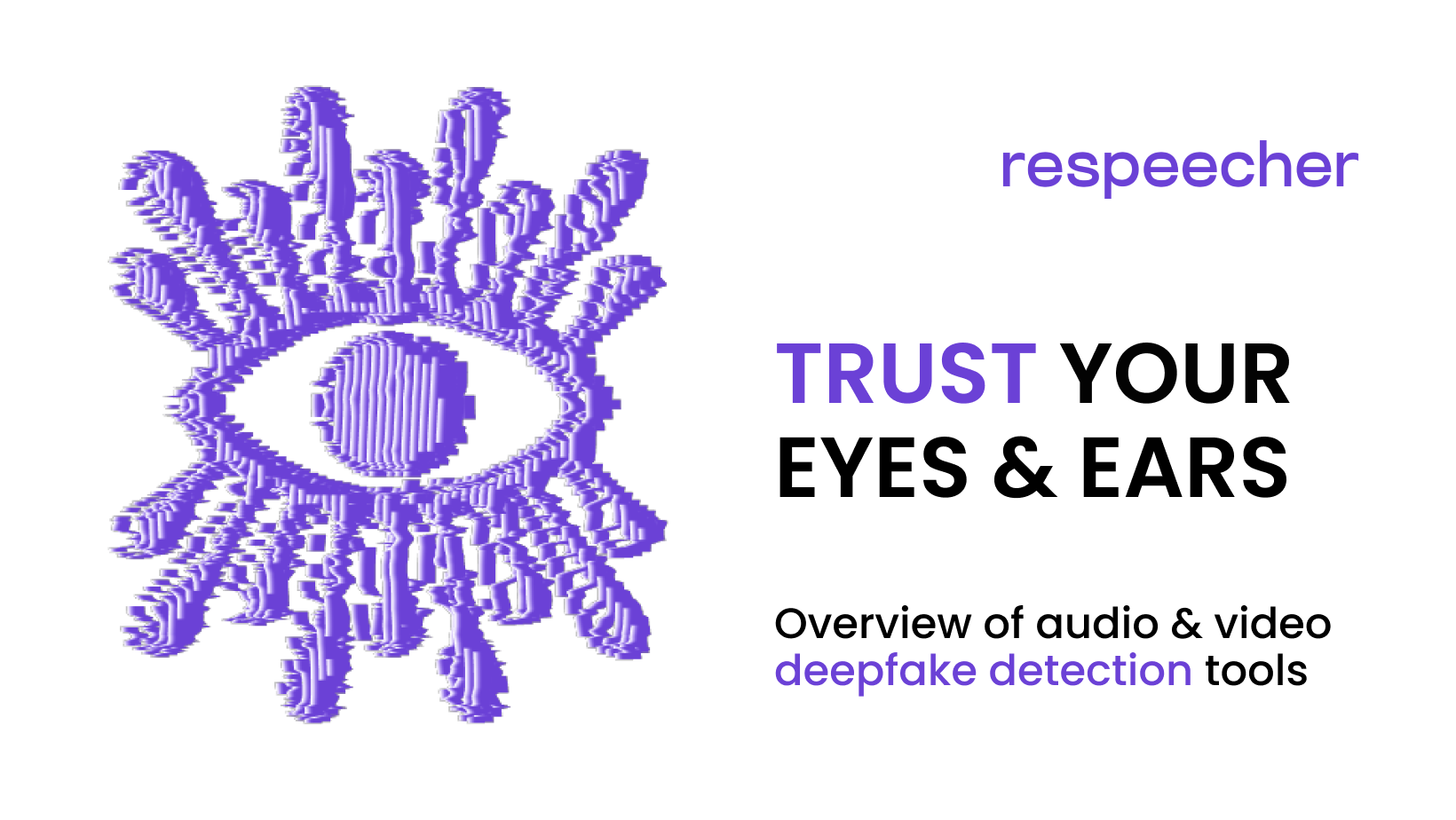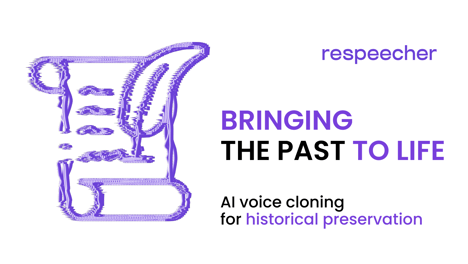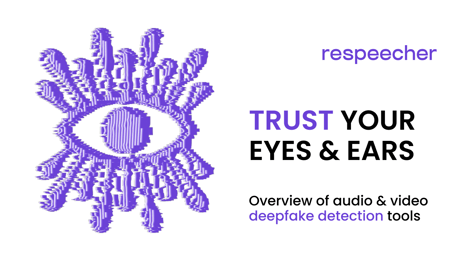Trust Your Eyes and Ears: Overview of Audio & Video Deepfake Detection Tools

Deepfakes are synthetic media in which a person in an existing image or video is replaced with someone else's likeness. Deepfakes can create highly convincing fake audio and video content using advanced machine learning and artificial intelligence techniques. While the technology can be used for harmless entertainment and creative purposes, it also poses significant risks.
On a societal level, deepfakes can spread misinformation, influence political processes, and undermine public trust in media. Individually, deepfakes can lead to identity theft, blackmail, and severe emotional distress, particularly when used to create non-consensual explicit content. Given the potential for harm, developing and deploying reliable AI tools for deepfake analysis to know how to spot deepfakes.
Understanding Deepfakes
Deepfakes are created using machine learning algorithms, particularly generative adversarial networks (GANs), which are trained on large datasets of images or videos. For video deepfakes, these algorithms analyze facial movements and expressions to superimpose one person's face onto another's body convincingly. Voice cloning, another technique, uses AI to mimic someone's voice by training on recordings of their speech patterns.
Today, deepfakes have been exploited in various malicious ways. In politics, they have been used to create fabricated speeches or interviews to sway public opinion. In the entertainment industry, celebrities have been targeted with fake explicit videos, damaging their reputations. Financial fraudsters have used deepfakes to impersonate executives and manipulate employees into transferring funds. These examples underscore the potential for deepfakes to deceive, manipulate, and harm individuals and institutions. Famous victims of deepfake technology include singer Taylor Swift, actors Morgan Freeman and Keanu Reeves, politicians Donald Trump, Barack Obama, and Volodymyr Zelenskyy.
Deepfake Detection Tools
Several advanced tools have emerged for audio deepfake identification and video deepfake checker:
- Deepware Scanner: A tool designed to analyze videos for signs of manipulation, such as unnatural facial movements or inconsistencies in lighting and shadows.
- Truepic: Known for its capabilities in verifying the authenticity of photos and videos through cryptographic verification and forensic analysis.
- Sensity AI: Specializes in detecting deepfake videos by analyzing facial movements and audio to identify inconsistencies and anomalies.
Respeecher is proud to have joined forces with 2 companies that specialize in deepfake detection:
Pindrop: Focuses on detecting and preventing fraud in voice communications by analyzing voice patterns, background noise, and other audio characteristics to identify potential threats and verify authenticity.
Reality Defender: Specializes in identifying and mitigating deepfake content and other manipulated media through real-time analysis, leveraging AI to detect visual and auditory anomalies in videos and images.
Deepfake detection tools leverage cutting-edge technologies, primarily AI and machine learning algorithms. They analyze various aspects of multimedia content, such as facial landmarks, voice patterns, and image artifacts. By comparing these features against patterns learned from extensive datasets of both authentic and deepfake content, these tools can identify discrepancies that indicate manipulation.
Some tools also employ cryptographic techniques to ensure the integrity and authenticity of digital media. As deepfake technology evolves, so do these detection methods, aiming to stay ahead of increasingly sophisticated manipulation techniques.
Challenges in Deepfake Detection
Ensuring accurate detection of deepfakes poses significant challenges. While detection tools are becoming more sophisticated, they must contend with the evolving complexity of deepfake technology. This can lead to occasional false positives in deepfake detection, where legitimate content is flagged as fake, or false negatives, where undetected deepfakes slip through.
Even the best deepfake detection software faces several limitations. They may struggle to detect well-crafted deepfakes or employ advanced techniques to evade detection. Additionally, the rapid evolution of machine learning deepfake technology means that detection methods must continually adapt to new manipulation strategies. For users, these limitations mean that while detection tools provide valuable protection, they are not foolproof and require ongoing development and improvement to maintain effectiveness against emerging threats.
What Users Can Do
For regular users, here are signs of deepfake content:
- Unnatural Facial Expressions: Watch for unnatural movements or inconsistencies in facial expressions, especially if they don't match the context of the video.
- Audio Inconsistencies: Listen closely for any unusual pauses, robotic tones, or inconsistencies in speech patterns.
- Contextual Clues: Consider the source and context of the content. Verify with credible sources if the video or audio seems suspicious.
- For children: teaching them about critical thinking in the digital age is important, encouraging them to question the authenticity of online content.
When using deepfake verification tools, follow these steps:
- 1. Choose a Reliable Tool: Select a reputable deepfake detection tool known for its accuracy and reliability.
- 2. Upload or Input Content: Upload the video or audio file directly into the tool or provide a link if applicable.
- 3. Interpret Results: Review the tool's analysis. Pay attention to any identified anomalies or warnings that suggest the content may have been manipulated.
- 4. Cross-Verification: If possible, cross-verify with multiple detection tools or consult experts if conflicting results or doubts about the authenticity of the content exist.
By being vigilant and using reliable deepfake countermeasures, individuals can better protect themselves from the potential harms of deepfake content.
Ethical Considerations and Future Outlook
Ethical considerations are crucial in developing and deploying AI technologies for deepfake detectors. Ensuring that these tools respect privacy, uphold transparency, and mitigate potential biases is essential. Developers must also consider the broader societal impacts of their technologies, including safeguarding against misuse and promoting trust in digital media.
Looking ahead, advancements in AI in deepfake detection technology will likely focus on enhancing accuracy and resilience against sophisticated manipulation techniques. AI algorithms will continue to evolve, leveraging techniques such as blockchain verification, advanced pattern recognition, and neural network architectures. Additionally, collaborations between researchers, industry experts, and policymakers will be vital in addressing emerging challenges and setting AI ethics standards for digital content verification.
As digital content creation and manipulation techniques evolve, so must our approaches to detecting and mitigating the risks posed by deepfakes, ensuring a more trustworthy and secure digital environment.
Conclusion
Educating the public about deepfakes and promoting the responsible use of deepfake detection algorithms are critical steps in combating the risks posed by synthetic media. By raising awareness of the potential harms and providing practical guidance on spotting deepfakes, people can better protect themselves and others from misinformation and exploitation. Moreover, ongoing advancements in ethical AI development, such as voice cloning with Respeecher, are essential to ensure that deepfake identification techniques uphold privacy, fairness, and reliability. Together, these efforts contribute to a safer digital landscape, fostering trust and integrity.
FAQ
Voice cloning technology uses AI to replicate a person's voice based on existing recordings. It relates to deepfakes as both technologies manipulate media to create convincing simulations, raising concerns about misuse and deception.
Look for unnatural facial movements, inconsistent lighting or shadows, and audio discrepancies like robotic tones or unusual pauses. Using reliable detection tools can also help verify authenticity.
Ethical concerns include misinformation, privacy violations, and potential for exploitation, such as the non-consensual use of personal likenesses or spreading false information that can harm individuals or societies.
Yes, several tools, such as Pindrop, Reality Defender, Deepware Scanner, Truepic, and Sensity AI specialize in detecting deepfakes by analyzing facial movements and audio inconsistencies and using AI algorithms to identify manipulated content.
Glossary
Deepfake
AI voice synthesis
Machine learning
False positive

- voice cloning
- voice cloning technology,
- AI voice
- AI Ethics
- Respeecher for Business
- voice ai
- ethics in AI
- deepfake
- deepfake detector
- deepfake detection tools
- audio deepfake identification
- video deepfake checker
- how to spot deepfakes
- best deepfake detection software
- machine learning deepfake
- signs of deepfake content
- deepfake verification tools
- AI tools for deepfake analysis
- deepfake detection algorithms
- false positives in deepfake detection
- deepfake countermeasures
- AI ethics and deepfakes
- future of deepfake detection
- deepfake identification techniques







